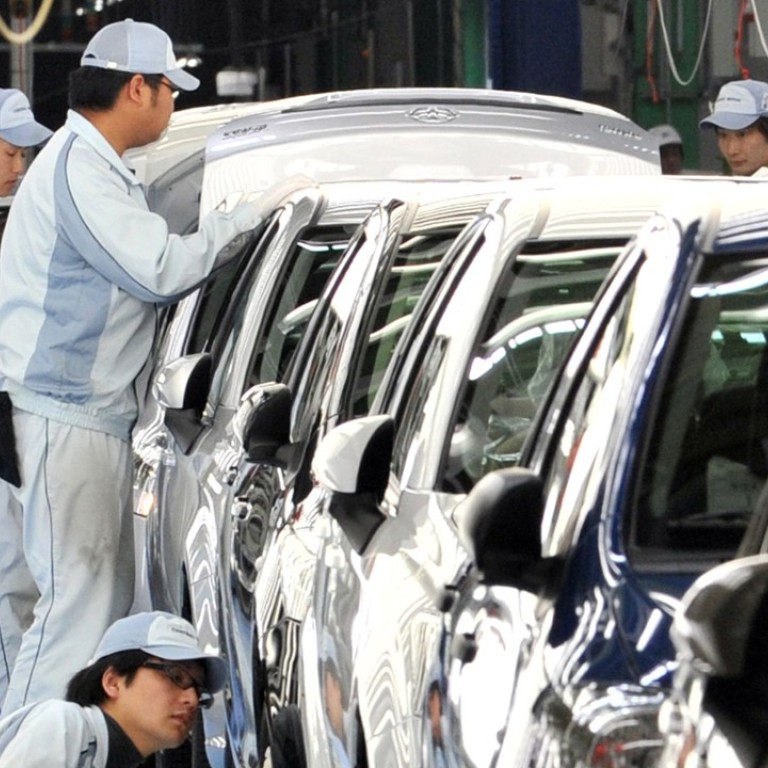
Trump’s trade war undermines Japan’s attempt to kick stalling wages and economy into higher gear
Tokyo’s 20-year quest for inflation had a rough July. Consumer prices stood at 0.8 per cent year-on-year, unchanged from June and a long way off from the Bank of Japan’s 2 per cent target.
To understand what’s going wrong, economists are scrutinising data on money supply, bank credit dynamics and zigs and zags in business surveys. Yet all the insights Japanologists need can be found at Toyota Motor headquarters.
Earlier this month, Japan Inc.’s premier name posted better-than-expected quarterly profits - up 7.2 per cent between April and June. That, on top of the tens of billions of dollars Toyota made in recent years from Prime Minister Shinzo Abe’s reflation programme. Make that the rest of Japan Inc., which has been gorging on BOJ liquidity and riding a weaker yen to record profits.
Workers have yet to feel the magic. When Toyota does open its wallet, it’s hardly worth labour’s while. In April, it announced a monthly base pay increase of 1,300 yen (US$11.60/HK$92). Herein lies why Japan is coming up short in its deflation fight - and why things might get worse.
This was supposed to be the year when Abenomics finally gained noticeable traction. Then came Donald Trump’s trade war, one escalating right before the eyes of an increasingly worried Tokyo establishment.
First came Trump’s tariffs of 25 per cent on steel and 10 per cent on aluminium. Then came levies on US$50 billion of Chinese goods on the way to as much as US$500 billion. The White House wants to devalue the US dollar and is threatening 25 per cent taxes on car imports.
By targeting Japan’s biggest export market and wreaking havoc with supply chains, Trump makes it less likely Toyota and other exporters will fatten paychecks.
BOJ Governor Haruhiko Kuroda’s deflation fight is getting trumped by other forces, too. One is the glacial pace of reforms needed to reanimate Japan’s animal spirits. When he took office in December 2012, Abe pledged to loosen labour markets, cut red tape, catalyse a start-up boom and narrow the gender pay gap. He erred, though, by turning to trickle-down economics.
Rather than upset vested interests, Abe nudged Kuroda’s team to open the monetary floodgates even more. Since Kuroda started in March 2013, the Nikkei 225 Index has jumped 81 per cent. Real wages, not so much. The reason: CEOs have been waiting for Tokyo’s reform big bang before sharing the wealth.
Now, headwinds emanating from Washington make the virtuous cycle Abenomics sought even less likely.
This isn’t just a Japan problem. Central banks from China to South Korea have shifted focus from inflation to supporting growth. Those raising interest rates are doing so largely to protect currencies weighed down by current-account deficits. Here, think Indonesia, India and the Philippines.
Might the BOJ go the other way, opening the credit spigot anew? Sure, though Kuroda’s inclination is to rely more on tweaks than additional monetary jolts. Japan has found, counter-intuitively, that pushing rates negative may actually be impeding credit creation.
Unable to profit off yields spreads between short- and long-term debt, bankers are becoming more risk-averse and lending less. It’s actually deadening Tokyo’s animal spirits. Also, the more Kuroda does to pump yen into the economy, the more he takes pressure off Abe’s team to modernise an insular economic model.
The real prize, though, is getting the Toyotas of Japan to raise salaries. Top-down Tokyo loves a precedent. None would matter more than the pride of Japan Inc. having the confidence to put BOJ policies in second gear.
On that front, July’s inflation data make for grim reading. They augur poorly for the rest of Japan’s 2018.
William Pesek is a Tokyo-based journalist and author. He has written for Bloomberg and Barron’s

